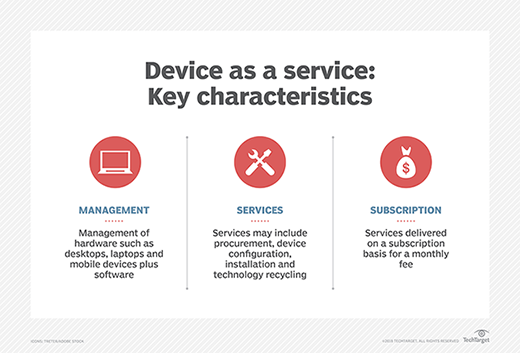What is device as a service (DaaS)?
The device as a service (DaaS) model offers PCs, smartphones and other mobile computing devices as a paid service. Device as a service eases the IT needs of a company by outsourcing the hardware, software and device management to an external provider. Subscribing to a provider lets an organization update its equipment at the end of the lease period without incurring the costs normally associated with a device refresh.
DaaS is considered part of the anything as a service. The trend for using these services has grown fast, starting with only one percent of PCs shipped as part of a DaaS program in 2014. Based on Grand View Research's market forecast, the global DaaS market size was valued at $83 billion in 2022 and is expected to grow to $757 billion by 2030.
How does DaaS work?
DaaS services for software and hardware management include device backups, asset tracking, security and end-of-life disposal. Devices offered as a service include hardware, such as PCs, laptops, desktops, tablets and mobile phones.
Device-as-a-service vendors provide a contract stating the hardware, software, services and lengths of time covered by their services. Payment is normally on a per-device basis. Some original equipment manufacturers offer DaaS with a limited number of choices from their overall device lineup. Users can't replace hardware they're using from a vendor when they wish. Typically, a contract states two, three or five-year timelines for device replacement.
This article is part of
What is desktop management and how does it work?
Devices typically come with the software the organization needs already installed. Usually, vendors also include an upgrade path for patches and updates.
Three pillars of DaaS
The following three areas make up DaaS services:
- Device fulfillment. DaaS providers supply businesses with the latest technology, preconfigured and ready to use. This lets DaaS customer skip large capital expenditures.
- Device services. This covers the ongoing support, maintenance, security updates and other IT management capabilities needed to keep devices operational.
- Device recovery. This includes the secure collection, refurbishment or disposal of outdated devices while protecting any sensitive business data stored on those devices.

DaaS pricing models
DaaS services offer different pricing models. The most common models include the following:
- Subscription-based. Businesses pay a monthly, quarterly, yearly or other type of recurring fee.
- Use-based. Costs are based on actual device use, which can allow organizations to scale their technology needs without overpaying for unused resources.
- Bundled. This approach combines hardware, software and IT support into a single pricing package.
- Full cycle. This covers the entire lifecycle of a device from purchase to end-of-life recycling and disposal.
- Customizable. This tailored approach lets organizations mix and match hardware and services based on their needs.
- Hardware-based. Customers get new hardware, delivery and setup without the need for upfront purchases.
- Service-based. This approach includes services such as maintenance, repairs and technical support.
What are the benefits of DaaS?
Device as a service can bring various benefits, mostly for smaller startup organizations. These benefits include the following:
- Organizations can scale devices up and down as needed, although scaling down can often only be done at the end of the contract period.
- Costs are changed from capital expenditures to operating expenses.
- IT staff's workload is reduced because device configuration is no longer required.
- DaaS includes automatic device management, such as patches and updates.
- It gives startups the ability to acquire a collection of devices without the normal, high upfront cost.
- It's a good option for smaller companies that lack in-house IT expertise.
- DaaS gives organizations the option of trading up for newer devices at the end of the contract period.
Drawbacks of the DaaS model
Although many potential benefits are associated with the device-as-a-service model, organizations should consider the possible disadvantages. They include the following:
- The organization never actually owns the devices, even though it is paying for them in perpetuity.
- Despite vendor claims to the contrary, the total cost of ownership can be higher in some cases.
- Because vendors service and maintain devices, privacy can be a concern.
- DaaS might not be an option in certain regulated industries.
- Device selection can be limited to certain models.
Common DaaS options
Two primary examples of device-as-a-service offerings are from HP and Lenovo. HP offers HP Managed Device Services, which has device options ranging from commercial notebooks, desktops and specialized devices. It has even expanded to offering hardware outside of HP's hardware, such as Apple Macs, iPhones and iPads.
Lenovo also has a DaaS initiative called Lenovo TruScale Device as a Service. It offers customers a range of devices such as PCs, tablets, smartphones and video conferencing and collaboration tools.
Who uses DaaS?
DaaS is used in a variety of businesses and industries. The most common include:
- Enterprises.
- Startups and small and medium businesses.
- Healthcare providers.
- Online and brick-and-mortar retailers.
- Educational institutions.
- Financial service providers.
- Governments agencies.
Device as a service vs. desktop as a service
Device as a service shares the DaaS acronym with desktop as a service, which can be confusing when using the acronym. With device as a service, physical hardware is offered to customers under a subscription model. This can include PCs, tablets, smartphones and other physical devices.
Desktop as a service is a cloud computing offering where a third party offers a virtual desktop running on a cloud-based virtual machine (VM). The desktop-as-a-service provider hosts the back end of a virtual desktop infrastructure deployment, and the guest operating system runs inside a VM on a physical server that resides in the cloud service provider's data center.
Desktop-as-a-service providers bill their customers monthly, based on the number of virtual desktops they're using. In contrast, device-as-a-service providers usually require an annual or multiyear commitment.
Device as a service is often compared to PC as a service. Learn the difference between DaaS and PCaaS.







